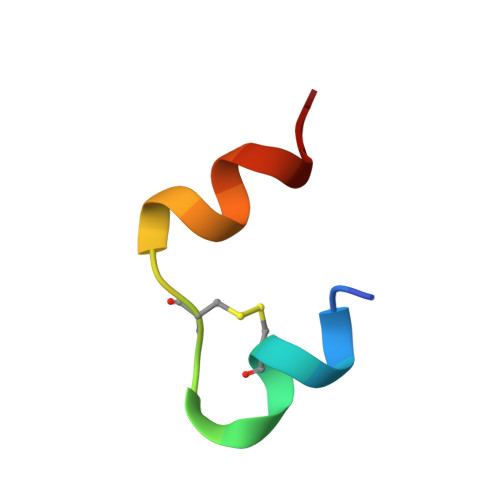Unraveling the symmetry ambiguity in a hexamer: calculation of the R6 human insulin structure.
O'Donoghue, S.I., Chang, X., Abseher, R., Nilges, M., Led, J.J.(2000) J Biomol NMR 16: 93-108
- PubMed: 10723989
- DOI: https://doi.org/10.1023/a:1008323819099
- Primary Citation of Related Structures:
2AIY, 3AIY, 4AIY, 5AIY - PubMed Abstract:
Crystallographic and NMR studies of insulin have revealed a highly flexible molecule with a range of different aggregation and structural states; the importance of these states for the function of the hormone is still unclear. To address this question, we have studied the solution structure of the insulin R6 symmetric hexamer using NMR spectroscopy. Structure determination of symmetric oligomers by NMR is complicated due to 'symmetry ambiguity' between intra- and intermonomer NOEs, and between different classes of intermonomer NOEs. Hence, to date, only two symmetric tetramers and one symmetric pentamer (VTB, B subunit of verotoxin) have been solved by NMR: there has been no other symmetric hexamer or higher-order oligomer. Recently, we reported a solution structure for R6 insulin hexamer. However, in that study, a crystal structure was used as a reference to resolve ambiguities caused by the threefold symmetry; the same method was used in solving VTB. Here, we have successfully recalculated R6 insulin using the symmetry-ADR method, a computational strategy in which ambiguities are resolved using the NMR data alone. Thus the obtained structure is a refinement of the previous R6 solution structure. Correlated motions in the final structural ensemble were analysed using a recently developed principal component method; this suggests the presence of two major conformational substates. The study demonstrates that the solution structure of higher-order symmetric oligomers can be determined unambiguously from NMR data alone, using the symmetry-ADR method. This success bodes well for future NMR studies of higher-order symmetric oligomers. The correlated motions observed in the structural ensemble suggest a new insight into the mechanism of phenol exchange and the T6 <--> R6 transition of insulin in solution.
- European Molecular Biology Laboratory, Heidelberg, Germany.
Organizational Affiliation:


















